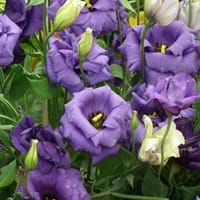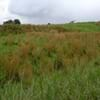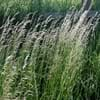Life Span
Biennial
Perennial
Type
Flowering Plants, Grass, Herbs
Tree
Origin
Southwestern United States, Mexico
Northeastern United States, Mid-Atlantic United States, Southeastern United States, Central United States, Canada, Mexico
Types
'Balboa White' lisianthus, 'Forever Blue' lisianthus, 'Forever White' lisianthus, 'Lisa Pink' lisianthus
Plains Cottonwood, Rio Grande cottonwood
Habitat
Grassland, Warmer regions
bottomlands, Floodplain, Hardwood forests, Riverbanks
USDA Hardiness Zone
8-11
3-9
Sunset Zone
1a, 1b, 2a, 2b, 3a, 3b, 4, 5, 6, 7, 8, 9, 10, 11, 12, 13, 14, 15, 16, 17, 18, 19, 20, 21, 22, 23, 24
1a, 1b, 2a, 2b, 3a, 3b, 4, 5, 6, 7, 8, 9, 10, 11, 14, 15, 16, 17, 18, 19, 20, 21
Habit
Upright/Erect
Upright/Erect
Minimum Height
Not Available
Minimum Width
Not Available
Flower Color
White, Blue, Pink, Lavender, Blue Violet
Red, Green
Flower Color Modifier
Bicolor
Bicolor
Fruit Color
Not Available
White
Leaf Color in Spring
Gray Green
Green, Gray
Leaf Color in Summer
Gray Green
Green
Leaf Color in Fall
Gray Green
Yellow
Leaf Color in Winter
Gray Green
Not Available
Leaf Shape
Succulent
Toothed curved and flat petiole
Plant Season
Spring, Summer
Summer, Fall
Sunlight
Full Sun, Partial Sun
Full Sun
Growth Rate
Slow
Very Fast
Type of Soil
Clay, Loam, Sand
Loam, Sand
The pH of Soil
Neutral, Alkaline
Acidic, Neutral
Soil Drainage
Well drained
Average
Bloom Time
Spring, Late Spring, Early Summer, Summer, Late Summer
Early Spring
Tolerances
Not Available
Drought, Soil Compaction, Wet Site
Where to Plant?
Container, Ground, Pot
Ground
How to Plant?
Seedlings, Stem Planting
Seedlings, Stem Planting
Plant Maintenance
Medium
Low
Watering Requirements
Form a Soil ring to water efficiently, It cannot sustain wet-feet, Keep the ground moist but not water-logged, Use Mulches to help prevent water loss during hot and windy weather, Water twice a day in the initial period
Keep ground moist, Requires regular watering, Requires watering in the growing season, Water daily during growing season, Water Deeply, Water more in summer
In Summer
Lots of watering
Ample Water
In Spring
Moderate
Ample Water
In Winter
Average Water
Average Water
Soil pH
Neutral, Alkaline
Acidic, Neutral
Soil Type
Clay, Loam, Sand
Loam, Sand
Soil Drainage Capacity
Well drained
Average
Sun Exposure
Full Sun, Partial Sun
Full Sun
Pruning
Cut or pinch the stems, Prune ocassionally, Remove dead or diseased plant parts, Remove deadheads
Remove dead branches, Remove hanging branches
Fertilizers
All-Purpose Liquid Fertilizer
fertilize in growing season, Nitrogen
Pests and Diseases
Botrytis Blight, Cercospora leaf spot, Cucumber mosaic, Curvularia blotch, Downy mildew, Fusarium stem rot, Fusarium wilt, Impatiens necrotic spot, Lisianthus necrosis, Phyllosticta leaf spot, Pythium root rot, Rhizoctonia stem rot, Sclerophoma stem blight, Tobacco mosaic
Aphids, Borers, Caterpillars, Insects
Plant Tolerance
Drought
Drought, Soil Compaction, Wet Site
Flower Petal Number
Single, Double, Semi-Double
Not Available
Foliage Texture
Medium
Medium
Foliage Sheen
Matte
Glossy
Attracts
Bees, Butterflies
Not Available
Allergy
Chest tightness, Diarrhea, Dizziness, Nausea, Vomiting
Hay fever, Headache, Runny nose, sneezing
Aesthetic Uses
Beautification, Bouquets, Showy Purposes, Used for decorating walls, fences, gates, hedges, etc.
Landscape Designing
Beauty Benefits
Not Available
No Beauty Benefits
Environmental Uses
Air purification
Air purification, Forms dense stands, Prevent Soil Erosion, Shadow Tree, Shelter for wildlife, Wildlife, Windbreak
Medicinal Uses
Not Available
Anodyne, Anthelmintic, anti-inflammatory, Febrifuge
Part of Plant Used
Flowers
Inner Bark, Leaves, Seeds
Other Uses
Showy Purposes, Used for fragrance
Biomass for fuel, Used as firewood, Used As Food
Used As Indoor Plant
Yes
No
Used As Outdoor Plant
Yes
Yes
Garden Design
Bedding Plant, Container, Cutflower, Mixed Border, Wildflower
Screening / Wind Break, Shade Trees
Botanical Name
EUSTOMA grandiflorum
POPULUS deltoides
Common Name
Lisianthus
Eastern Cottonwood
In Hindi
Lisianthus
Eastern Cottonwood
In German
Lisianthus
Eastern Cottonwood
In French
Lisianthus
Cottonwood Orient
In Spanish
Lisianthus
Cottonwood del Este
In Greek
Lisianthus
Ανατολική Cottonwood
In Portuguese
Lisianthus
Cottonwood Oriental
In Polish
Eustoma
Eastern Cottonwood
In Latin
Lisianthus
Orientalium Poplar
Phylum
Magnoliophyta
Anthophyta
Class
Magnoliopsida
Dicotyledonae
Order
Gentianales
Salicales
Family
Gentianaceae
Salicaceae
Clade
Angiosperms, Asterids, Eudicots
Angiosperms, Eudicots, Rosids
Tribe
Not Available
Not Available
Subfamily
Not Available
Salicoideae
Season and Care of Lisianthus and Eastern Cottonwood
Season and care of Lisianthus and Eastern Cottonwood is important to know. While considering everything about Lisianthus and Eastern Cottonwood Care, growing season is an essential factor. Lisianthus season is Spring and Summer and Eastern Cottonwood season is Spring and Summer. The type of soil for Lisianthus is Clay, Loam, Sand and for Eastern Cottonwood is Loam, Sand while the PH of soil for Lisianthus is Neutral, Alkaline and for Eastern Cottonwood is Acidic, Neutral.
Lisianthus and Eastern Cottonwood Physical Information
Lisianthus and Eastern Cottonwood physical information is very important for comparison. Lisianthus height is Not Available and width Not Available whereas Eastern Cottonwood height is 3,050.00 cm and width 2,130.00 cm. The color specification of Lisianthus and Eastern Cottonwood are as follows:
Lisianthus flower color: White, Blue, Pink, Lavender and Blue Violet
Lisianthus leaf color: Gray Green
Eastern Cottonwood flower color: Red and Green
- Eastern Cottonwood leaf color: Green and Gray
Care of Lisianthus and Eastern Cottonwood
Care of Lisianthus and Eastern Cottonwood include pruning, fertilizers, watering etc. Lisianthus pruning is done Cut or pinch the stems, Prune ocassionally, Remove dead or diseased plant parts and Remove deadheads and Eastern Cottonwood pruning is done Remove dead branches and Remove hanging branches. In summer Lisianthus needs Lots of watering and in winter, it needs Average Water. Whereas, in summer Eastern Cottonwood needs Ample Water and in winter, it needs Average Water.





